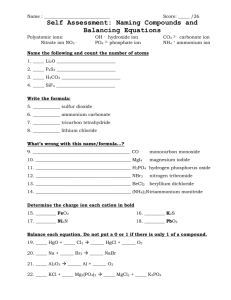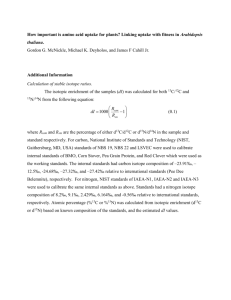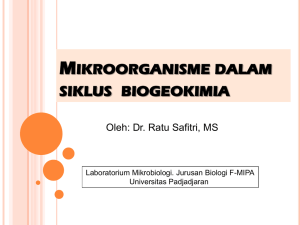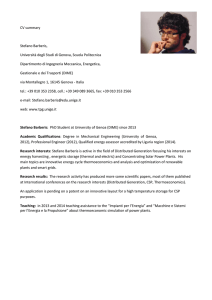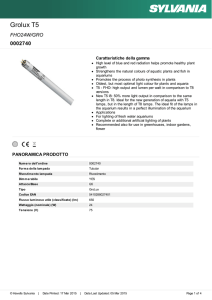powerpoint - Retno Mastuti
advertisement
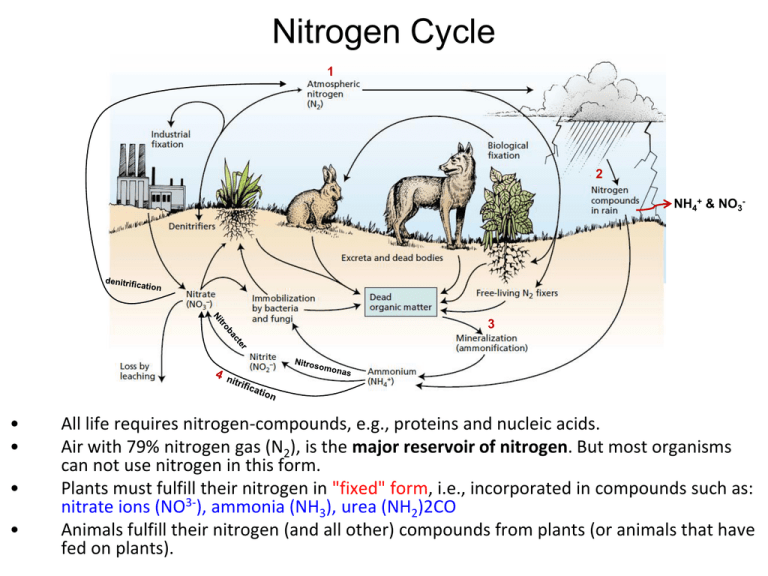
Nitrogen Cycle 1 2 NH4+ & NO3- 3 • • • • All life requires nitrogen-compounds, e.g., proteins and nucleic acids. Air with 79% nitrogen gas (N2), is the major reservoir of nitrogen. But most organisms can not use nitrogen in this form. Plants must fulfill their nitrogen in "fixed" form, i.e., incorporated in compounds such as: nitrate ions (NO3-), ammonia (NH3), urea (NH2)2CO Animals fulfill their nitrogen (and all other) compounds from plants (or animals that have fed on plants). In general, the nitrogen cycle has five steps: 1. 2. 3. 4. 5. Nitrogen fixation (N2 to NH3/ NH4+ or NO3-) Nitrification (NH3 to NO3-) Assimilation (Incorporation of NH3 and NO3- into biological tissues) Ammonification (organic nitrogen compounds to NH3) Denitrification (NO3- to N2) Industrial Fixation • Under great pressure, at 600°C, and with the use of a catalyst, atmospheric nitrogen and hydrogen (usually derived from natural gas or petroleum) can be combined to form ammonia (NH3). • Ammonia can be used directly as fertilizer, but most of its is further processed to urea and ammonium nitrate (NH4NO3). Natural Fixation Atmospheric Fixation Biological Fixation • during lightning, nitrogen and oxygen combine to form nitric oxide. • The nitric oxide then reacts with more oxygen to form nitrogen dioxide dissolve in rain, forming nitric acids. • This nitric acid reacts with minerals of the soil to form soluble nitrates. Atmospheric nitrogen fixation probably contributes some 5-8% of the total nitrogen fixed. The ability to fix nitrogen is found only in certain bacteria. Some live in a symbiotic relationship with plants of the legume family (e.g., soybeans, alfalfa). • Some establish symbiotic relationships with plants other than legumes (e.g., alders). • Some nitrogen-fixing bacteria live free in the soil. • Nitrogen-fixing cyanobacteria are essential to maintaining the fertility of semi-aquatic environments like rice paddies. • Decomposing • • • • Dead organism source of organic matter Decomposer (microorganisms) will break down the molecules in excretions and dead organisms into ammonia ammonification Ammonification : N organic NH4+ , at low temperature, various pH Ammonia can be taken up directly by plants - usually through their roots. However, most of the ammonia produced by decay is converted into nitrates. Nitrification : NH4+ will be oxidized to form nitrates , at warm humid soil pH 7 Bacteria Nitrosomonas oxidize NH4 to nitrites (NO2-). Bacteria Nitrobacter oxidize the nitrites to nitrates (NO3-). Nitrate assimilation in plants Two steps : 1. Reduction of nitrat to nitrit (cytosol; nitrate reductase (NR)) nitrate reductase (NR) 2 identical polypeptide each contain prosthetic groups : FAD, heme, pterin (complex Mo-organic molec) in cytosol leaf (photosynthetic) or root (non photosynthetic) nitrate, light, carbohydrate affect NR activities 2. Reduction of nitrite to NH4+ (kloroplas/plastid → nitrit reduktase) donor electron in leaf: ferredoxin derive from photosynthetic electron transport donor electron in non green tissue (root): NADPH derive from oxidative pentose phosphate Reduksi nitrit menjadi ammonium • Di daun membutuhkan 6 e- dari H2O pd fotosistem non siklik kloroplas • Cahaya mendorong pengangkutan e- dari H2O ke Feredoksin (Fd) • Fd tereduksi menyediakan 6 e- utk mereduksi NO2menjadi NH4+ • Fereduksin tereduksi : donor elektron utk nitrit reduktase di daun Pengubahan amonium menjadi bahan organik • NH4+ tidak ditimbun di suatu tempat di tumbuhan • NH4+ bersifat toksik : menghambat pembentukan ATP di mitokondria / kloroplas • NH4+ diubah menjadi gugus amina pada glutamin • Selanjutnya membentuk: glutamat, asam aspartat, asparagin Pengubahan amonium menjadi bahan organik PEP karboksilase Asparagin sintetase Dari feredoksin di kloroplas atau NADH/NADPH di proplastid sel non fotosintetik Glutamin sintase (GS) Glutamat sintase GOGAT Bentuk penyimpan nitrogen utama Protein, klorofil, asam nukleat, dll. Biological Nitrogen Fixation • Conversion of nitrogen into compounds by combining with carbon, hydrogen and oxygen before it can be absorbed by the plants. • It requires a complex set of enzymes and a huge expenditure of ATP. This is known as nitrogen fixation. • Although the first stable product of the process is ammonia, this is quickly incorporated into protein and other organic nitrogen compounds. The micro-organisms which can fix atmospheric nitrogen can be classified into two main groups i. Symbiotic micro-organisms. The symbiotic bacterium Rhizobium (saprofit !) is found in association with the root nodules (acts as a site of Nitrogen fixation) of the leguminous plants ii. Free living micro-organisms Fiksasi N2 Tumbuhan dapat memfiksasi N2 Bakteri sianobakter Tumbuhan tidak dapat memfiksasi N2 Bakteroid, sel-sel korteks Sumber N utama NO3- dan NH4+, NH4+ segera dioksidasi menjadi NO3- → nitrifikasi Proliferasi sel, bintil akar Asimilasi nitrat bakteroid, fiksasi N Menghasilkan NH4+ NH4+ diubah menjadi senyawa organik/transaminasi http://bcs.whfreeman.com/thelifewire8e/content/cat_010/f36009.jpg Pembentukan nodul/bintil akar Sinyal kimiawi dari akar Dikenal bakteri Bakteri merombak dinding sel, bakteri masuk ke dalam sel bulu/rambut akar Membentuk benang infeksi dari membran plasma, bakteri membelah di benang infeksi Sitoplasma : leghemoglobin, mengangkut O2 ke bakteroid, mengatur jumlah O2 Benang infeksi ; sel- korteks Bakteri dilepas dlm sitoplasma sel tetraploid (sel diploid ?) Sel tetraploid membelah proliferasi jaringan bintil akar Bakteri membesar : bakteroid, berkelompok dikelilingi membran peribakteroid Formation of root nodules • When a root hair of a leguminous plant comes in contact with the bacterium-Rhizobium, it curls or becomes deformed. • At the site of curling, the rhizobia (bacteria) invade the root tissue. • Some of the bacteria within the root tissue enlarge to become membrane bound structures called bacteroids. These cannot divide, while some bacteria remain untransformed to facilitate further infection. • The plant responds to this invasion by forming an infection thread made up of plasma membrane that grows inward from the infected cell of the host, separating the infected from the rest of the plant. • Cell division in the infected tissue leading to nodule formation. • The nodule thus formed establishes a direct vascular connection with the host for the exchange of nutrients. Fiksasi N2 oleh bakteroid • di bintil akar: N2 + 8 e- + 8 H+ + 16 ATP 2 NH3 + H2 + 16 ADP + 16 Pi • • Energi ATP dan elektron diperoleh dari oksidasi KH/sukrosa Oksidasi KH pd bakteroid menyebabkan : reduksi NAD + → NADH atau NADP + → NADPH • • NH3- / NH4+ diangkut keluar bakteroid menuju sitosol Sitosol : NH4+ diubah menjadi bentuk utama nitrogen (glutamin, asam glutamat, asaparagin) yang diangkut dari bintil akar ke bagian tumbuhan yang lain glutamin, asam glutamat, asaparagin: bentuk utama nitrogen yang diangkut ke sel perisiklus (dekat berkas pembuluh yg mengelilingi bintil) → xilem → daun → floem → akar dan bagian lain • Faktor-faktor yang mempengaruhi fiksasi N • Laju fotosintesis : Kelembaban tinggi, suhu hangat, sinar matahari cukup, [CO2] tinggi → fiksasi N • Genetis (mikroba) : Proses pengenalan spesies bakteri – tumbuhan, kemampuan nitrogenase mereduksi H+ • Tahap pertumbuhan : tertinggi setelah pembungaan, saat perkembangan reproduktif (kebutuhan N di biji dan buah yang sedang berkembang ) Nitrogen Cycle - Nitrogen Assimilation http://bcs.whfreeman.com/thelifewire8e/content/cat_010/f36010.jpg
